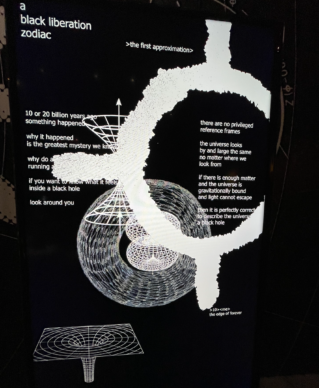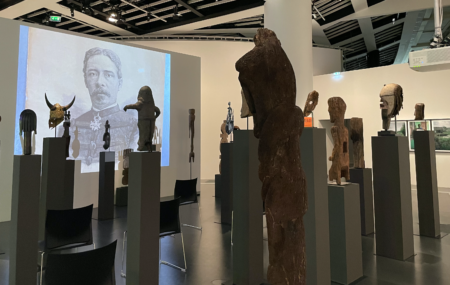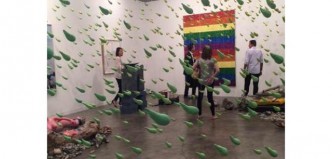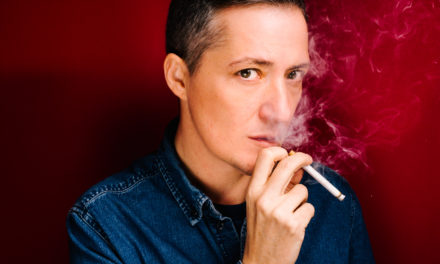Heritage of the traumas
For some time now colonialism, slavery and the heritage of these traumas has been at the centre of an unusual kind of attention, giving rise to what was once called “history painting” up until the 19th century, only in a new genre.
Tina M.Campt

The phenomenon, omnipresent in art itself and extending to the art market, can be identified by what Tina M. Campt, a professor of contemporary culture at Brown University, refers to as “a Black artistic renaissance”. This is associated in part with the great emergence of the Black Lives Matter movement. She writes that a tsunami of artworks by black artists is sweeping the globe.
Black Gaze
Her new book is entitled “A Black Gaze: Artists Changing How We See” (MIT Press). “The central argument of this book is that Black contemporary artists are creating new ways of visualizing Black struggle and transcendence, and in doing so they offer a different trajectory for Black sociality.”
Arthur Jafa
One example she cites is Arthur Jafa (born in 1960), the author behind the video masterpiece from 2016, “Love is the message, the message is death”, among other works. Jafa’s work features in the collections of the Metropolitan Museum in New York and was awarded the Golden Lion at the Venice Biennale in 2019. It was on this occasion that the artist explained to us: “I talk about the impossibility of a black experience that is animated by a feeling of innocence. We are simultaneously a product of the West and of Africa.”
A new langage
In his videos Arthur Jafa has invented a new language that uses images sourced online – historical, dramatic, and often violent – and arranges them with sonic accompaniments that make them resonate hypnotically. And he has set a precedent (See here, here and here some interviews of Arthur Jafa). There are now large numbers of artists who are working in a similar vein.
Kerry James Marshall
One of his great friends, the African-American painter Kerry James Marshall (born in 1955), has also invented a new style but in his case with painting. His works are genre scenes similar to those made in the 18th century, except they feature the contemporary life of African Americans. In a seminal drawing from 1980, KJM – as he is known to aficionados – depicted himself in black against a black background. Since then, his figures have been painted black and not brown, contrasting with their frequently very colourful contexts.
Ralph Ellisson

Through this gesture he explicitly references a novel by the African-American writer Ralph Ellison, first published in 1952, “Invisible Man”, which observed the lack of existence in social representation of this section of the population. This new superstar of American painting was the subject of a retrospective in 2016-2017 that has done the rounds of the major American museums ( See here the report about the retrospective).
In the absence of light

Kehinde Wiley
He is also credited in a documentary recently broadcast on HBO called “Black Art: In the Absence of Light”. The film addresses the subject of two veritable history paintings, the official portraits of President Barack Obama and the former First Lady, depicted respectively by two artists from the community, Kehinde Wiley and Amy Sherald. A powerful symbolic choice. Both portraits are going to go on a tour of the United States, organized by the Smithsonian’s National Portrait Gallery, stopping off at five American cities between June 2021 and May 2022 (https://npg.si.edu/obamaportraitstour).

Amy Sherald
Theaster Gates
But most significantly we see the figure who gave the documentary its title, the charismatic artist and performer Theaster Gates (born in 1975) who is calling for African Americans to have their own sites for exhibition and research while awaiting what he calls “the light”, in other words a complete success, on an equal footing with white artists (See here a report about Theaster Gates).
Musée National de l’Histoire de L’immigration
In Paris, the subject doesn’t have the same impact. The Musée national de l’immigration (National Museum of Immigration) is devoting an exhibition called “Ce qui s’oublie et ce qui reste” (What is Forgotten and What Remains) to exchanges with Africa through the eyes of contemporary artists.
Sébastien Gokalp
The director Sébastien Gokalp believes that the situation for France, in terms of its treatment of colonial history, is less dramatized: “Generally speaking, in France the issue is addressed from a perspective claiming to be universalist and republican that says: ‘we are all equal’. In the United States there is a greater focus on differences in physicality, community and religion. The protests there have a greater impact, especially for the black population, following the painful history of slavery and segregation.
Malik Nejmi

Malick Nejmi (detail)
In both cases history must be rewritten, but the protests in France, including amongst artists, are less acute.” He cites the example of the visual artist of Moroccan origin who lives in Orléans, Malik Nejmi (born in 1973). During a time of fierce debate over national identity, he has made a video projected onto two screens placed back to back, showing on one side his grandmother’s grave in Rabat and on the other his children playing in the gardens of the Villa Medici while he was staying there as a resident of the French Academy in Rome. “I have two memories, two countries that are significant to my vision, who through their history have made an asylum for the family,” he writes in the catalogue.
Cool the passions
“The purpose of the museum is to cool the passions by presenting societal, historical and artistic elements,” explains Sébastien Gokalp. “What is Forgotten and What Remains” is part of the programming for an African season in France, Africa 2020, running until July 2021.
N’Goné Fall
This multidisciplinary cultural season, which gives a voice to the African continent and its diasporas, is led by the dynamic Senegalese curator N’Goné Fall. She observes a certain deficit in the French museum scene in this area: “The United States has opened museums dedicated to African-American culture such as the Smithsonian in Washington. In Bordeaux, for example, the families who amassed wealth through the slave trade are still there. But no museums have been created that address this issue.”
Epicentre of the triangular trade
It is in Nantes, the epicentre of the triangular trade, that the art centre “Le Lieu unique” is staging the exhibition “Université des futurs africains” (University of African Futures) as part of Africa 2020. The curator Oulimata Gueye allows us to discover artists from the continent who revisit world history in unprecedented ways.
Nolan Oswald Dennis
The South African Nolan Oswald Dennis (born in 1988) wants to reappropriate… the sky. He has developed a “Black Liberation Zodiac”, a colossal project for translating and recodifying the astrological constellations in line with the radical black liberation movements. His oeuvre takes the form of installations which he says: “show the sky differently, presenting a black awareness of space”.

Nolan Oswald Dennis
Kader Attia
In France, the most famous artist who addresses postcolonialism is the Franco-Algerian Kader Attia (born in 1970) (See the report about Kader Attia here). Known for his works that explore the idea of reparation, he has been named curator of the Berlin Biennale, due to take place in 2022. At the exhibition at the musée du Quai Branly, “Ex Africa”, he has conceived an installation and a captivating video which address, according to different viewpoints, the thorny issue of the restitution of artworks to formerly colonized countries. He writes: “we think we are collecting objects, but they collect us. They are the embodiment of an inaccessible and invisible pleasure that attracts us endlessly.”

Kader Attia
A memorial to the victims of slavery
The very idea of a statue “charged” with meaning is characteristic of beliefs from Africa, the very place where the pieces he references were made. The Western world has created different monuments with a different symbolic “charge”. One of these, the memorial project designed to honour the victims of slavery which was due to be installed in the Jardin des Tuileries, and on which the names of 200,000 slaves freed in 1848 were meant to be written, is currently on hold. While a call for candidates was launched in June 2020, the ensuing discussions became mired in controversy within the committee that was meant to realize the project.

Adrian Piper
On the website of the magazine Artforum the American artist Adrian Piper, one of the five chosen candidates, described the process – which was Kafkaesque to say the least – which resulted in the monument being put on hold.
A group therapy
N’Goné Fall believes that, on the subject of slavery, “France needs to have group therapy.” It is still not engaged.
Support independent news on art.
Your contribution : Make a monthly commitment to support JB Reports or a one off contribution as and when you feel like it. Choose the option that suits you best.
Need to cancel a recurring donation? Please go here.
The donation is considered to be a subscription for a fee set by the donor and for a duration also set by the donor.




